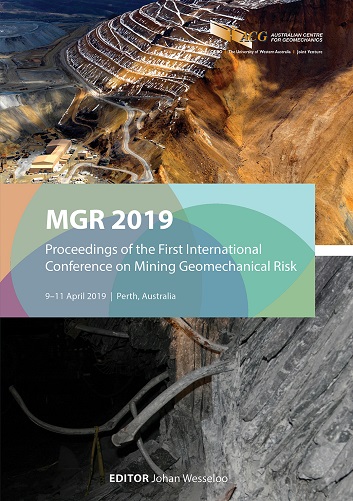Geotechnical risk-informed decision-making in mining

|
Authors: Lupo, JF |
DOI https://doi.org/10.36487/ACG_rep/1905_0.5_Lupo
Cite As:
Lupo, JF 2019, 'Geotechnical risk-informed decision-making in mining', in J Wesseloo (ed.), MGR 2019: Proceedings of the First International Conference on Mining Geomechanical Risk, Australian Centre for Geomechanics, Perth, pp. 61-68, https://doi.org/10.36487/ACG_rep/1905_0.5_Lupo
Abstract:
Uncertainty and variability are ever-present in the fields of geomechanics and geotechnical engineering. These uncertainties and variabilities can introduce risk into mine facilities (open pits, underground, tailings storage facilities, etc.). Traditionally, the Factor of Safety (FS) has been used as a measure of anticipated performance. In other words, if the FS meets the acceptance criteria, it is anticipated that the facility will perform in an acceptable manner. However, the FS, by itself, does not communicate anything about risk, nor variability or uncertainty. Reliability methods allow calculation of a Probability of Failure (PF), which can be integrated into a risk assessment. However, a PF assumes that all of the critical elements of a design have been adequately addressed. In either case, the FS and PF, by themselves, are of limited utility if performance measures (deformation, piezometric head, etc.) are not also defined as part of the acceptance criteria. Risk-informed decision-making (RIDM) provides an avenue to make informed risk decisions while providing a platform for defining the acceptance criteria. In this approach, there is a direct link between risk and performance. The RIDM process also allows the risk and acceptance criteria to be updated periodically, so that changes in the operation and/or performance can be considered. This approach is in contrast to the current practice where acceptance criteria are often defined without regard to the site conditions and where risk and acceptance criteria are treated as constants.
Keywords: risk-informed decision-making, geomechanics, acceptance criteria
References:
Australian National Committee on Large Dams 2003, Guidelines on Risk Assessments, Australian National Committee on Large Dams, Hobart.
Christian, JT, Ladd, CC & Baecher, GB 1994, ‘Reliability applied to slope stability analysis’, Journal of Geotechnical Engineering, vol. 120, no. 12, pp. 2180–2207.
Duncan, JM 2000, ‘Factors of safety and reliability in geotechnical engineering’, Journal of Geotechnical and Geoenvironmental Engineering, vol. 126, no. 4, pp. 307–316.
Federal Energy Regulatory Commission 2016, Risk Informed Decision Making, Federal Energy Commission, Washington DC, viewed 6 December 2018,
Gill, DE, Corthésy, R & Leite, MH 2005, ‘Determining the minimal number of specimens for laboratory testing of rock properties’, Engineering Geology, no. 78, vol. 1, pp. 29–51.
Lee, IM & Lee, MJ 1998, ‘Optimization of rock slopes using reliability concepts’, International Journal of Rock Mechanics and Mining Sciences, vol. 35, no. 4/5.
Montibeller, G & von Winterfeldt, D 2015, ‘Cognitive and motivational biases in decision and risk analysis’, Risk Analysis, vol. 35, no. 7, pp. 1230–1251.
National Research Council 1994, Science and Judgment in Risk Assessment, National Academy Press, Washington DC.
Olsson, F & Frantzich, H 2000, ‘A simple risk-based design method’, Proceedings of the 3rd International Conference On PerformanceBased Codes and Fire Safety Design Methods, The Society of Fire Protection Engineers, Gaithersburg.
Phoon, KK 2004, Towards Reliability-Based Design for Geotechnical Engineering, special lecture for Korean Geotechnical Society, Seoul, 9 July 2004.
Siefert, WT 2007, Cognitive Biases in Risk Management, master theses, University of Missouri, Columbia,
US Army Corps of Engineers 2003, Engineering and Design: Slope Stability, US Army Corps of Engineers, Washington DC.
van Gelder, P, Roos, A & Vrijling, H 2001, Risk-based Design of Civil Structures: Communications on Hydraulic and Geotechnical Engineering, Report No. 2001-01, Delft University of Technology, Delft.
Zhang, WG & Goh, ATC 2012, ‘Reliability assessment on ultimate and serviceability limit states and determination of critical factor of safety for underground rock caves’, Tunneling and Underground Space Technology, vol. 32, pp. 221–230.
Zio, E & Pedroni, N 2012, Risk-Informed Decision-Making Processes: An Overview, Foundation for an Industrial Safety Culture, Foundation for an Industrial Safety Culture, Toulouse.
© Copyright 2025, Australian Centre for Geomechanics (ACG), The University of Western Australia. All rights reserved.
View copyright/legal information
Please direct any queries or error reports to repository-acg@uwa.edu.au
View copyright/legal information
Please direct any queries or error reports to repository-acg@uwa.edu.au
